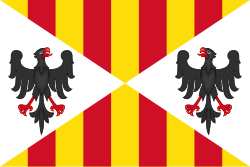Kingdom of Trinacria | |||||||||
|---|---|---|---|---|---|---|---|---|---|
| 1282–1442 | |||||||||
| Motto: Animus Tuus Dominus (Latin for 'Courage is thy Lord') (in use in the Sicilian Vespers of 1282) | |||||||||
 | |||||||||
| Status | Sovereign state (until 1412) Part of the Crown of Aragon (1412–1442) | ||||||||
| Capital | Palermo 38°35′31″N16°4′44″E / 38.59194°N 16.07889°E | ||||||||
| Religion | Roman Catholicism | ||||||||
| Demonym | Sicilian | ||||||||
| Government | Feudal monarchy | ||||||||
| King | |||||||||
• 1282–1285 | Peter I the Great | ||||||||
• 1416–1458 | Alfons V | ||||||||
| Legislature | Parliament | ||||||||
| Historical era | Middle Ages | ||||||||
| 4 September 1282 | |||||||||
| 31 August 1302 | |||||||||
| 1442 | |||||||||
| |||||||||
| Today part of | Italy Malta | ||||||||
The Kingdom of Trinacria was established after Sicilian Vespers in 1282, when King Peter III of Aragon ascended the throne, and was consolidated after the War of the Sicilian Vespers in 1302. According to the Peace of Caltabellota, the Kingdom of Sicily was officially divided into two parts, one of which was the island part of Sicily, officially called the Kingdom of Trinacria [a] , but informally called the Kingdom of Sicily. [3] [4]
Since then, Sicily island was ruled as an independent kingdom by relatives of the House of Barcelona, and was then added permanently to the Crown of Aragon as a result of the Compromise of Caspe of 1412. [5] [6] Meanwhile, the continental part of the Kingdom of Sicily, known colloquially as the Kingdom of Naples, remained under the crown of King Charles II of Anjou. The two resulting kingdoms were separated until 1442, when King Alfonso V of Aragon conquered the Kingdom of Naples and unified both Kingdoms. [7]

